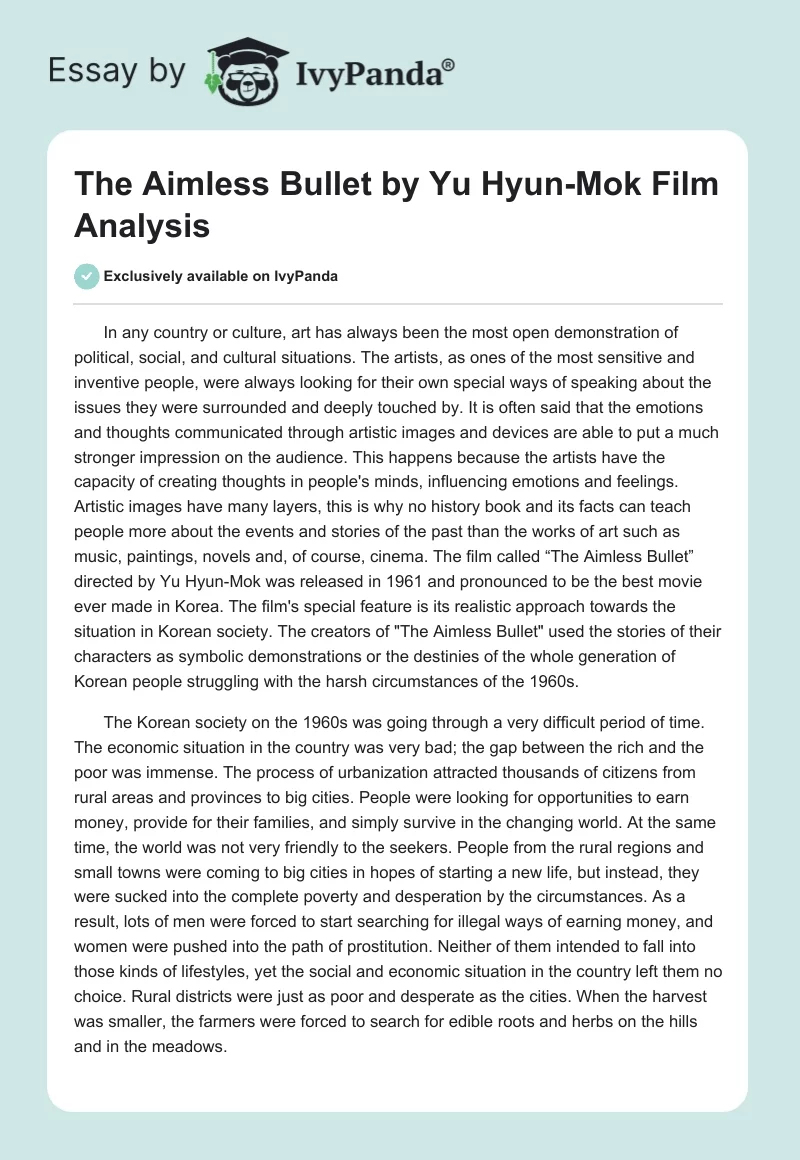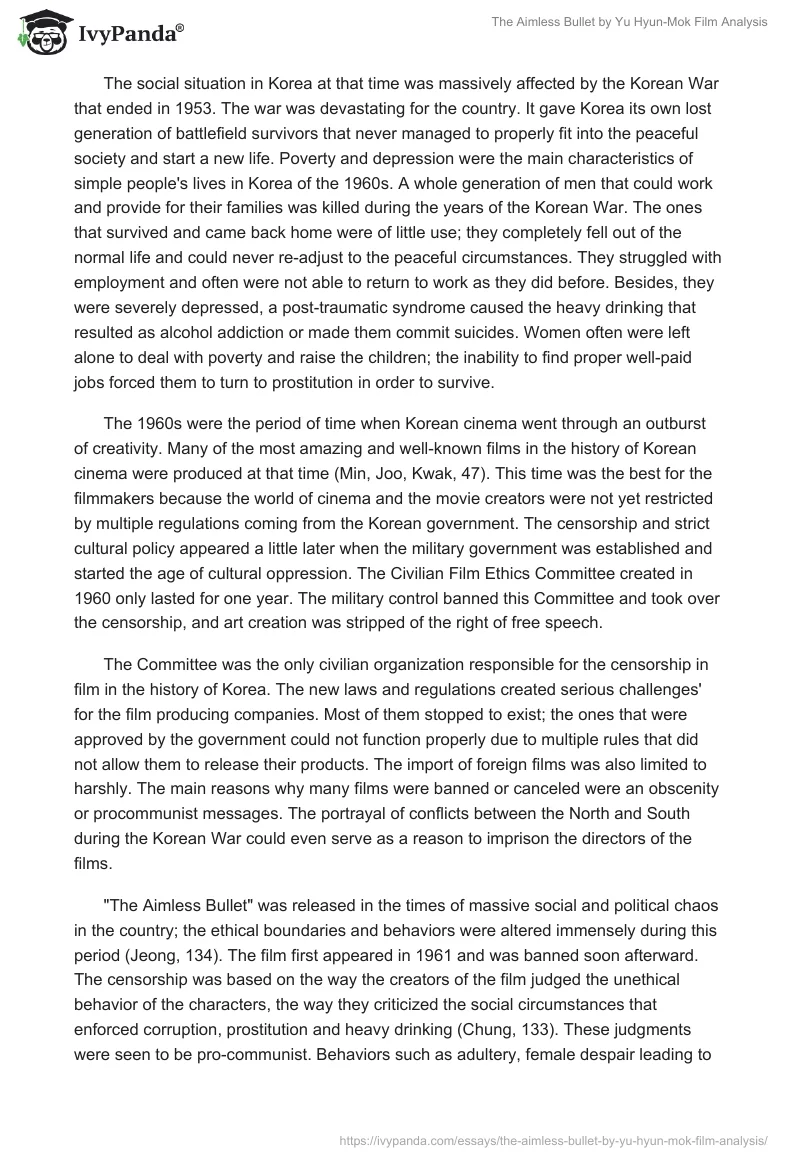In any country or culture, art has always been the most open demonstration of political, social, and cultural situations. The artists, as ones of the most sensitive and inventive people, were always looking for their own special ways of speaking about the issues they were surrounded and deeply touched by. It is often said that the emotions and thoughts communicated through artistic images and devices are able to put a much stronger impression on the audience. This happens because the artists have the capacity of creating thoughts in people’s minds, influencing emotions and feelings. Artistic images have many layers, this is why no history book and its facts can teach people more about the events and stories of the past than the works of art such as music, paintings, novels and, of course, cinema. The film called “The Aimless Bullet” directed by Yu Hyun-Mok was released in 1961 and pronounced to be the best movie ever made in Korea. The film’s special feature is its realistic approach towards the situation in Korean society. The creators of “The Aimless Bullet” used the stories of their characters as symbolic demonstrations or the destinies of the whole generation of Korean people struggling with the harsh circumstances of the 1960s.
The Korean society on the 1960s was going through a very difficult period of time. The economic situation in the country was very bad; the gap between the rich and the poor was immense. The process of urbanization attracted thousands of citizens from rural areas and provinces to big cities. People were looking for opportunities to earn money, provide for their families, and simply survive in the changing world. At the same time, the world was not very friendly to the seekers. People from the rural regions and small towns were coming to big cities in hopes of starting a new life, but instead, they were sucked into the complete poverty and desperation by the circumstances. As a result, lots of men were forced to start searching for illegal ways of earning money, and women were pushed into the path of prostitution. Neither of them intended to fall into those kinds of lifestyles, yet the social and economic situation in the country left them no choice. Rural districts were just as poor and desperate as the cities. When the harvest was smaller, the farmers were forced to search for edible roots and herbs on the hills and in the meadows.
The social situation in Korea at that time was massively affected by the Korean War that ended in 1953. The war was devastating for the country. It gave Korea its own lost generation of battlefield survivors that never managed to properly fit into the peaceful society and start a new life. Poverty and depression were the main characteristics of simple people’s lives in Korea of the 1960s. A whole generation of men that could work and provide for their families was killed during the years of the Korean War. The ones that survived and came back home were of little use; they completely fell out of the normal life and could never re-adjust to the peaceful circumstances. They struggled with employment and often were not able to return to work as they did before. Besides, they were severely depressed, a post-traumatic syndrome caused the heavy drinking that resulted as alcohol addiction or made them commit suicides. Women often were left alone to deal with poverty and raise the children; the inability to find proper well-paid jobs forced them to turn to prostitution in order to survive.
The 1960s were the period of time when Korean cinema went through an outburst of creativity. Many of the most amazing and well-known films in the history of Korean cinema were produced at that time (Min, Joo, Kwak, 47). This time was the best for the filmmakers because the world of cinema and the movie creators were not yet restricted by multiple regulations coming from the Korean government. The censorship and strict cultural policy appeared a little later when the military government was established and started the age of cultural oppression. The Civilian Film Ethics Committee created in 1960 only lasted for one year. The military control banned this Committee and took over the censorship, and art creation was stripped of the right of free speech.
The Committee was the only civilian organization responsible for the censorship in film in the history of Korea. The new laws and regulations created serious challenges’ for the film producing companies. Most of them stopped to exist; the ones that were approved by the government could not function properly due to multiple rules that did not allow them to release their products. The import of foreign films was also limited to harshly. The main reasons why many films were banned or canceled were an obscenity or procommunist messages. The portrayal of conflicts between the North and South during the Korean War could even serve as a reason to imprison the directors of the films.
“The Aimless Bullet” was released in the times of massive social and political chaos in the country; the ethical boundaries and behaviors were altered immensely during this period (Jeong, 134). The film first appeared in 1961 and was banned soon afterward. The censorship was based on the way the creators of the film judged the unethical behavior of the characters, the way they criticized the social circumstances that enforced corruption, prostitution and heavy drinking (Chung, 133). These judgments were seen to be pro-communist. Behaviors such as adultery, female despair leading to prostitution eventually became some of the most common attributes of the “hostess melodrama” that became a very popular genre in Korean cinema of the 1970s.
The film shows a poor family struggling to survive in the rotting post-war society. The family and all of its members are the collective images of the most common representatives of the Korean people of that time. The main character, Young-ho, is a family man that cannot provide for his relatives. His brother is a typical representative of a veteran that is suffering from alcoholism together with his army mates and is later thrown to the criminal path out of desperation. His sister is forced to become a prostitute and work for foreign men, who had money as opposed to Korean men. His mother is a mentally ill old lady that became insane after she experienced bombing during the war between the North and the South, she keeps thinking that she is under attack over and over again, and she yells “Let’s go!” trying to get out of the imaginary battlefield and save herself. His wife is a working pregnant woman that dies trying to have her baby because of complications caused by the health issues from too much hard labor.
The family comes from a village destroyed by the battles. All of its members are severely depressed and are struggling to find the sense of living in the horrible conditions they have to deal with every day. Each of the adults has serious health issues. All of these characters are typical for the Korean society of that time. The film director gathered them all in one family as a quintessence of the social situation in the country and as a symbol of the whole post-war period. The behaviors of these people and their choices are dictated by the circumstances, all the characters are forced to be what they are. With the help of these examples, the creators of the film demonstrated that the ethical behavior and mentality of Korean people were massively affected by the political and economic situation. The poverty that caused depression and pushed people to look for alternative ways to earn money and survive was the main force that stimulated the social degradation of that time.
The protagonist of the film is devastated by his inability to provide for his big family. Through the course of the events depicted in the film, he also keeps having very strong tooth and headaches, which add to his sufferings and finally lead to his loss of self-control and orientation. At the end of the film, he finally gets his tooth pulled out. After that, he gets into a cab and says, “Let’s go!”. The final phrase is symbolic; it refers to the behavior of Young-ho’s insane mother. Just like her, he wants to get out of the horrible surroundings that ruin his life and the lives of his close people.
The special technique the film creators use is the sounds. They are a big part of the message carried by the film, the background laughter of drunken prostitutes, farewell songs of the soldiers, the noise made by passing trains, singing of the villagers. Another method used by the creators was the shaking light and frames, which helped to emphasize the unstable social conditions of that depressive time. This technique brought new element and creativity to the Korean cinema (Shin, 18).
The scene that demonstrates the social and political conditions of the 1960s in Korea starts with a song about motherland, when Young-ho enters his home, carrying his paycheck, his wife takes it, knowing it is too little, and his daughter says that her uncle promised to buy her new clothes, even though she knew he lied. The parents are sad about being poor, the camera shows Young-ho, then his wife, and each shot is accompanied by the whispering voice of Young-ho’s mother saying “Let’s go!”. Her whisper matches the thoughts of other adults tired of poverty and inability to improve their own lives, provide for the kids, and take care of their own health.
The film always shows the main characters surrounded by their friends and colleagues, demonstrating that other people are also struggling with the conditions of their lives and searching for ways to survive, women are either depressed or extremely materialistic and only care about money, men drink heavily and search for the services of prostitutes. All of the additional characters are there to show that Young-ho’s family is only a tiny part, a symbol of the general situation and common desperation of the Korean society of the time.
Works Cited
Chung, Hue Seung. Toward a Strategic Korean Cinephilia: A Traditional Detournement of Hollywood Melodrama.
Jeong, Kelly. “Nation Rebuilding and Postwar South Korean Cinema: The Coachman and The Stray Bullet”. Journal of Korean Studies 11.1 (2006), 127-162. Print.
Min, Eungjun, Jinsook Joo, Han Ju Kwak. Korean Film: History, Resistance and Democratic Imagination. Westport: Greenwood Publishing Group, 2003. Print.
Shin, Ki-Seub. “Korean Independent Film & Japanese Colonialism” (2008). ProQuest. Web.


